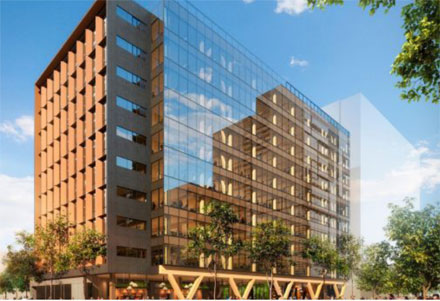
Australia’s largest timber building will call Brisbane home in a deal worth $140 million between developer Lendlease and the Liberman family-backed Impact Investment Group. Sources: Sydney Morning Herald, Australian Financial Review
Known as 5 King, the property will be one the final projects to be delivered in the $2.9 billion renewal of the Brisbane Showgrounds precinct in Fortitude Valley.
Standing at more than 52 metres, the 14,000 square metres of nine storeys of engineered timber on the A-grade site, with retail space at ground level, is targeting a 6 Green Star Design & As Built rating.
It will eclipse the Forte timber apartment building in Melbourne’s Docklands by four storeys and well overshadow the six-storey Docklands by four storeys and well overshadow the six-storey International House Sydney at Barangaroo, all of which were developed by Lendlease.
It has been suggested that Accenture is looking at moving into the Barangaroo site when its lease at GPT Group’s Workplace6 office tower expires in about 2020.
Under the plan IIG will fund the Brisbane property through its development, and own the property at practical completion, which is due in late 2018. It has been bought on a net passing yield of 6.5%.
It was designed by Bates Smart, whose director, Philip Vivian, said timber buildings are seen as the next generation of workplace “for a creative class looking for rich environments that enhance wellbeing and productivity”.
Lendlease chief executive property Australia Kylie Rampa said 5 King is the latest example of high-performance workplaces “setting new benchmarks in environmentally sustainable building practices”.
“The office building will offer tenants the opportunity to generate significant business benefits through large, efficient floorplates that provide flexibility for a variety of modern workplace formats,” Ms Rampa said.
The appeal of buildings made from engineered timber are that they have a lower carbon footprint than other building materials. The production process produces zero waste, and timbers are sourced from certified sustainably-managed forests. They also produce less CO2 during ongoing operation.
IIG chief executive Chris Lock said the group’s long-term view on the Brisbane office market is that the demand will continue to strengthen, “particularly for A-grade and new office stock in and around the Fortitude Valley and Urban Regen precincts”.
Mr Lock said the anchor tenant will be the global engineering and infrastructure advisory firm Aurecon, also the project’s lead engineer.
Aurecon has committed to a 6500 sqm, 10-year lease over four office levels and a small amount of the ground floor. According to Neil Barr, Aurecon’s Queensland regional director, the use of timber to lower the carbon footprint is a medium that Aurecon has used “to good effect”.
“Aurecon has been closely involved in providing structural and building services engineering design for 5 King, and has taken an active role in reducing building costs through digital design and modularisation,” Mr Barr said.
Meanwhile, Melbourne will get its first 10-storey commercial tower built out of cross-laminated timber, sitting on top of an existing six-storey commercial office building.
Victorian Planning Minister Richard Wynne approved Hume Partners Property’s application for the structure, which will be built out of locally sourced timber and which Hume Property managing director Scott Davies said could have a build time of 12 to 14 months.
The approval of the tower, which will contain 220 serviced apartments, demonstrates the commercial benefit for developers of timber. Using traditional steel and concrete
would only have permitted an extra six levels, or 140 apartments, Mr Davies said.
“We wouldn’t have received the level of interest among the hotel operators if it wasn’t for the fact that we could deliver up to 220 rooms,” he told The Australian Financial
Review on Wednesday.
“There was demand for more, not less. Six storeys, or 140 rooms, were considered unviable by the majority of operators for the location given the underlying demand.”
The project is also a shot in the arm for the state government’s bid to develop a local manufacturing industry that can supply CLT, a product that is carbon neutral, fully recyclable and can be cut to required size and shape off site for quick and efficient on site assembly.
“This is all about promoting innovation, supporting jobs in Melbourne and Victoria and growing our state’s world-class tourism offerings,” Planning Minister Richard Wynne said.





